fatman17
PDF THINK TANK: CONSULTANT

- Joined
- Apr 24, 2007
- Messages
- 32,563
- Reaction score
- 98
- Country
- Location
Lal Kurti – an epitome of religious co-existence
By Shiraz Hassan
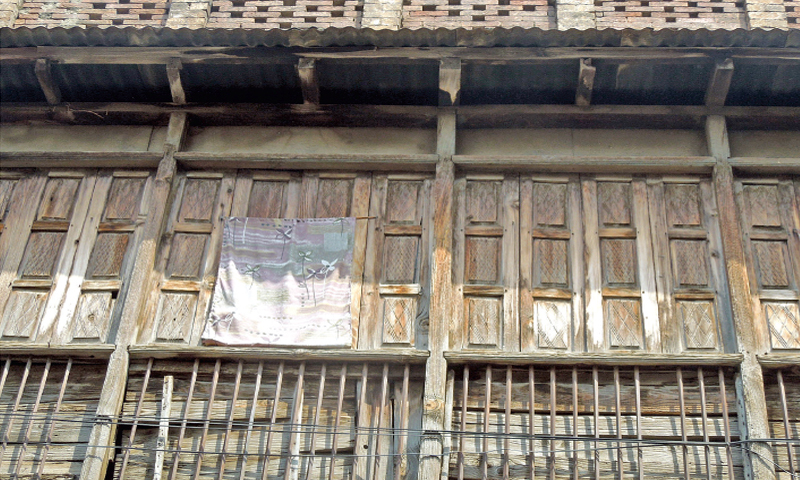
The wooden balcony of an old house.
In the heart of Rawalpindi Cantonment, a locality named Lal Kurti represents the multi-ethnic texture of the society, which sets an example of co-existence and pluralism.
Lal Kurti is one of the oldest residential areas of Rawalpindi, having been established in the mid-19th century during the British colonial era.
The formal name of Lal Kurti Bazaar is British Infantry Bazaar, but it is more commonly known as Lal Kurti, which means ‘Red Shirts’ in Urdu.

One of the Havelis from the pre-partition period in Lal Kurti. Several old buildings in the area are well maintained by their residents.
It is said that the name was derived from the red coloured uniform of the Royal British Indian Army troops who were stationed here. During Ziaul Haq’s tenure Lal Kurti was renamed Tariqabad, but the name did not catch on.
Most of the residents migrated here from Indian cities of Jalandhar, Ludhiana, Delhi, Amritsar, etc. during the partition of India.
While walking through the bazaar one can see different signboards which bear names like ‘Ludhiana Tea Shop’, ‘Ajmeri Milk Shop’, ‘Jalandhar General Store’ and ‘Delhi Hotel’, among others. It shows the association of the migrants with their ancestral hometowns.
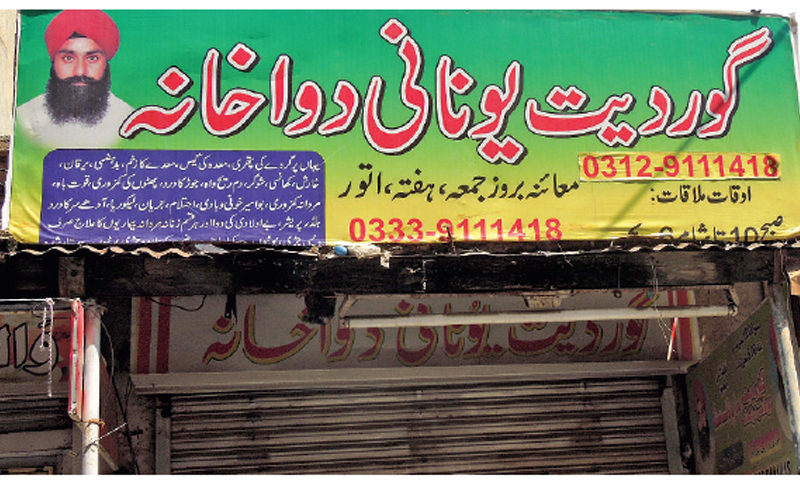
A signboard of a homeopathic clinic owned by a Sikh. The Lal Kurti area is known for its religious diversity where Muslims, Hindus, Christians and Sikhs live together.
Lal Kurti is one of the most religiously diverse localities of Pakistan. Muslims, Hindus, Sikhs and Christians have lived peacefully in this area for many years. There are around 2,000 Christians and approximately 50 Hindus living in the area.
“The Hindus were rich and fond of building beautiful houses,” said Chaudhry Mohammad Sabir, 74, one of the oldest residents of Lal Kurti. He recalled that Lal Kurti was a clean area in the early 1950s, but the population increased and streets narrowed with the passage of time.
The Christian and Hindu community feels secure here.
“We have been living here since before the partition,” said Prem Chand. “We are safe, we are free and we have good terms with our neighbours.”
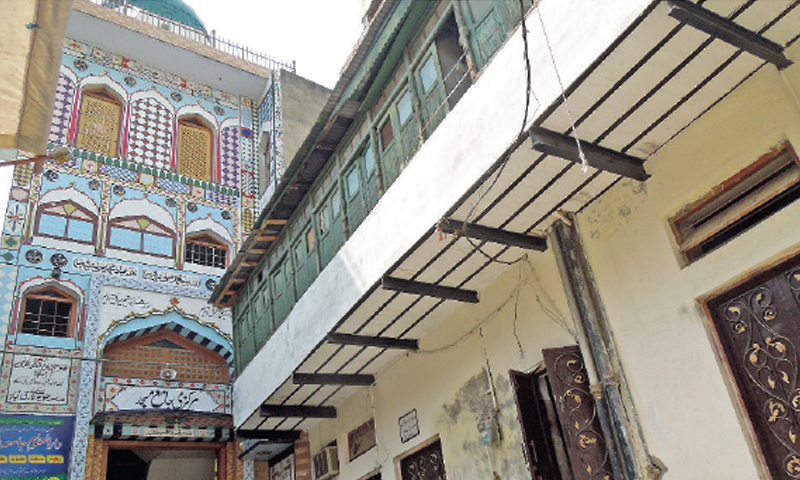
A colonial style balcony of an old house near the main Jamia Mosque in Lal Kurti.
There is an active temple here too, known as Valmiki temple, where Hindus celebrate their religious festivals.
“We celebrate and mourn together,” said Babu Mohammad Idrees, a political and social worker of Lal Kurti.
“Recently a Christian died in the area and the number of Muslims at his funeral was more than the Christians. Moreover we celebrate Holi, Diwali, Christmas and Eid festivals together,” he said.
“Despite the religious diversity, not a single incident of hate-speech or ethnic clash has been reported,” said Idrees. “Religious co-existence is the trademark of Lal Kurti.”
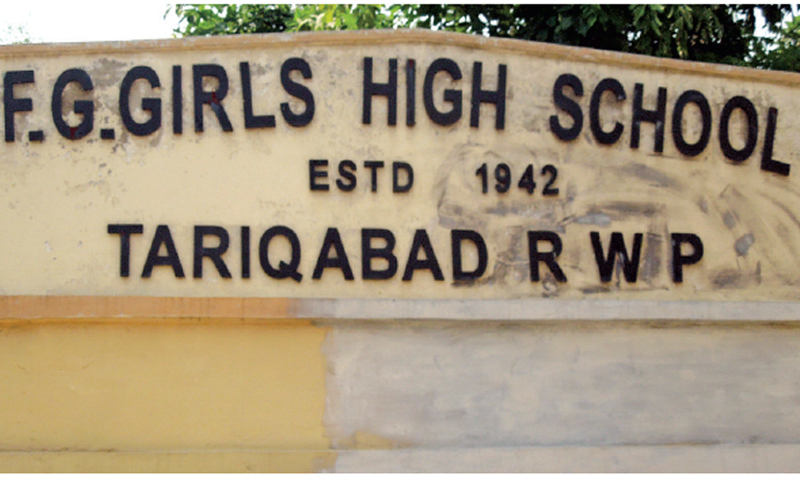
F.G. Girls High School established in 1942. The official name of Lal Kurti was changed to Tariqabad in the 1980s but it appears only in a few places.
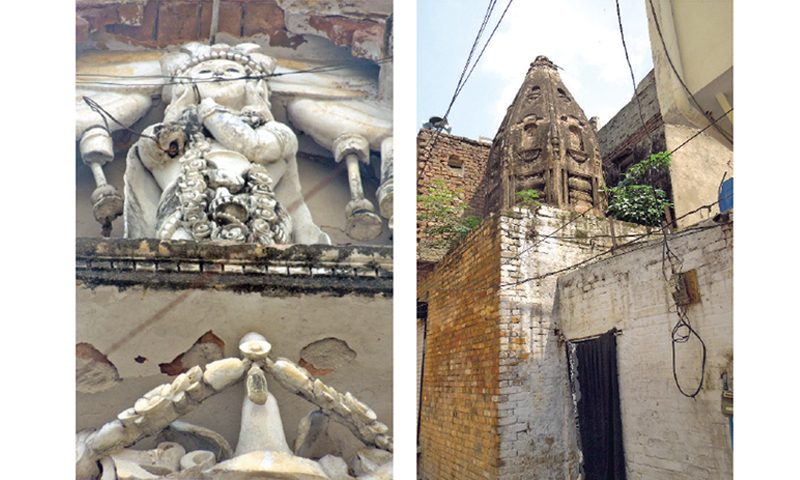
The statue of a woman perched on the entrance of a Haveli. & This Hindu temple is now inhabited by a Muslim family.

After partition many Muslim migrant families from different parts of India settled in Lal Kurti. Several shop owners named their businesses after the cities they had migrated from like this Ludhiana Tea Shop.

Prem Chand sits at Valmiki Mandir, one of the three active temples in the city. There is a sizeable population of Hindus in the area.
— Text and Photos by Shiraz Hassan
Published in Dawn, August 21st, 2014
By Shiraz Hassan

The wooden balcony of an old house.
In the heart of Rawalpindi Cantonment, a locality named Lal Kurti represents the multi-ethnic texture of the society, which sets an example of co-existence and pluralism.
Lal Kurti is one of the oldest residential areas of Rawalpindi, having been established in the mid-19th century during the British colonial era.
The formal name of Lal Kurti Bazaar is British Infantry Bazaar, but it is more commonly known as Lal Kurti, which means ‘Red Shirts’ in Urdu.

One of the Havelis from the pre-partition period in Lal Kurti. Several old buildings in the area are well maintained by their residents.
It is said that the name was derived from the red coloured uniform of the Royal British Indian Army troops who were stationed here. During Ziaul Haq’s tenure Lal Kurti was renamed Tariqabad, but the name did not catch on.
Most of the residents migrated here from Indian cities of Jalandhar, Ludhiana, Delhi, Amritsar, etc. during the partition of India.
While walking through the bazaar one can see different signboards which bear names like ‘Ludhiana Tea Shop’, ‘Ajmeri Milk Shop’, ‘Jalandhar General Store’ and ‘Delhi Hotel’, among others. It shows the association of the migrants with their ancestral hometowns.

A signboard of a homeopathic clinic owned by a Sikh. The Lal Kurti area is known for its religious diversity where Muslims, Hindus, Christians and Sikhs live together.
Lal Kurti is one of the most religiously diverse localities of Pakistan. Muslims, Hindus, Sikhs and Christians have lived peacefully in this area for many years. There are around 2,000 Christians and approximately 50 Hindus living in the area.
“The Hindus were rich and fond of building beautiful houses,” said Chaudhry Mohammad Sabir, 74, one of the oldest residents of Lal Kurti. He recalled that Lal Kurti was a clean area in the early 1950s, but the population increased and streets narrowed with the passage of time.
The Christian and Hindu community feels secure here.
“We have been living here since before the partition,” said Prem Chand. “We are safe, we are free and we have good terms with our neighbours.”

A colonial style balcony of an old house near the main Jamia Mosque in Lal Kurti.
There is an active temple here too, known as Valmiki temple, where Hindus celebrate their religious festivals.
“We celebrate and mourn together,” said Babu Mohammad Idrees, a political and social worker of Lal Kurti.
“Recently a Christian died in the area and the number of Muslims at his funeral was more than the Christians. Moreover we celebrate Holi, Diwali, Christmas and Eid festivals together,” he said.
“Despite the religious diversity, not a single incident of hate-speech or ethnic clash has been reported,” said Idrees. “Religious co-existence is the trademark of Lal Kurti.”

F.G. Girls High School established in 1942. The official name of Lal Kurti was changed to Tariqabad in the 1980s but it appears only in a few places.

The statue of a woman perched on the entrance of a Haveli. & This Hindu temple is now inhabited by a Muslim family.

After partition many Muslim migrant families from different parts of India settled in Lal Kurti. Several shop owners named their businesses after the cities they had migrated from like this Ludhiana Tea Shop.

Prem Chand sits at Valmiki Mandir, one of the three active temples in the city. There is a sizeable population of Hindus in the area.
— Text and Photos by Shiraz Hassan
Published in Dawn, August 21st, 2014


